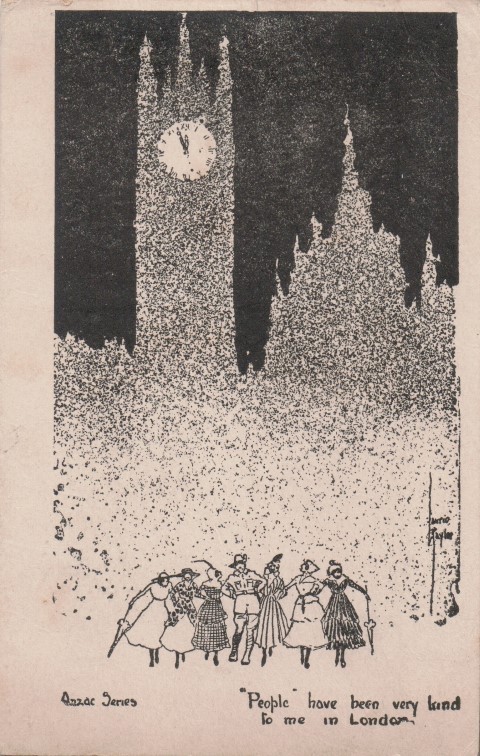Blog Archives
Greetings from afar
During the First World War the Australian Comforts Fund co-ordinated the distribution of small gifts to soldiers to make their life a little more pleasant.
It was formed in August 1916 and co-ordinated the efforts made by various existing State based patriotic funds. In the field, its activities were overseen by commissioners who held honorary rank as officers. Local Drummoyne Alderman, Mayor and politician, Thomas Henley was one such commissioner who visited Egypt, France and Britain in his work for the Australian Comforts Fund. His own son, Lieutenant Harold Leslie Henley was killed in action on 15 August 1916 in France.
This postcard was distributed to soldiers by the Australian Comforts Fund at Christmas 1916. It was sent by Private Henry George Jeffery to his family in Five Dock. Harry was killed in action on 4 October 1917 in Belgium.
The postcard artwork is by Laurie Tayler (Lawrence B. Tayler), an Australian artist and cartoonist of the period. The gentle humour of the postcard (‘People have been very kind to me in London’) belies the horror of the First World War experience.
Keeping in contact
Postcards and letters with news of home were important for soldiers during the First World War. Likewise, those at home treasured messages received from their loved ones on active service, as demonstrated by the album kept by Margaret Jeffery, in which each piece of correspondence from her two sons and nephew was lovingly preserved.
On the back of one postcard, Private Henry (Harry) Jeffery writes to his family in Five Dock,’I have not had any letters for sometime now. We all feel glad when we come off parade and find a letter on the table for us. If a chap does not get a letter and sees one of his mates with one, he says lucky beggar’.
The humorous postcard, above, sent by Harry has a more serious and touching note on the back,’Keep the home fires burning. Be of good cheer. Don’t worry I will be allright (sic). I am trusting in the Lord to come through.’
News from the front
Mail during the First World War was censored so as to keep any operational details secret. At the Front, communication was reduced to filling in a form letter like the one above sent by Harry Jeffery to his mother.
There were ways of getting around the censor. Harry noted in one letter to his family that ‘at one port we called at soldiers threw letters to the people on the wharf to post. I am going to do the same next time.’ While training in Britain, he wrote a long letter to his family about the journey from Sydney to Portsmouth and posted it while on leave away from the base, to avoid the censor.
The postcard, above, was filled in using an indelible pencil which had a purple dye mixed in with the graphite. Indelible pencils were popular as it meant that a soldier did not need to carry a pen and ink. As the name suggests the writing could not be rubbed out (unless a censor used his indelible pencil to cross out the writing).
A Christmas wish
Surprisingly, from the midst of the horrors of the First World War came one of the prettiest of souvenirs. Embroidered silk postcards were first made at the time of the Paris Exhibition in 1900 and became a popular souvenir between 1914 and 1918.
The postcards were produced in France by French and Belgian women. Panels were hand-embroidered by women and girls at home then sent to factories where they were cut and mounted on to card. The cards provided income for women and were a popular souvenir for soldiers to send home. An estimated ten million embroidered postcards were made during the war.
Generally the postcards were sent through military mail pouches so many of these fragile cards have survived in good condition. Their beauty and link with loved ones ensured that they were treasured by those receiving them.
The postcard, above, was sent from France by Alfred Robert Cassidy to his Aunt Margaret Jeffery in Five Dock in 1916. The sentiments of the card still remain true today.
Greetings across the years
Before text messages, email or the telephone people kept in contact through postcards which could be mailed relatively cheaply and often reached the recipient by the next post.
Local Studies has a small collection of postcards featuring images of our area. The collection was built up with the advice and assistance of local historian Pam Liell, herself a collector of postcards. Pam has compiled two books of postcard images, Before the phone: 100 years of postcard messages (1998) and Messages from the war: postcards of World War I (1999) both of which are held in the Local Studies collection.
The early 1900s postcard above shows the Parramatta River near Yaralla which is just visible in the background, along with the Yaralla wharf which no longer exists.
The Local Studies postcards have been digitised and are available through Canada Bay Connections. A selection of Parramatta River postcards can be viewed on flickr.






![4444566778_476b2f71cd_z[1]](https://canadabayconnections.files.wordpress.com/2012/12/4444566778_476b2f71cd_z1.jpg?w=604&h=369)